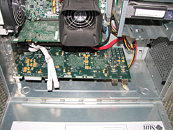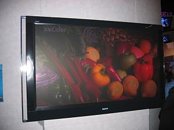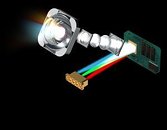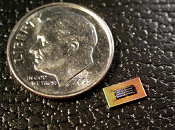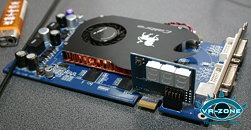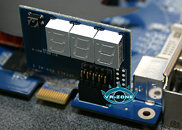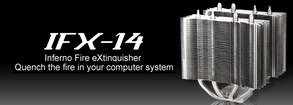News Posts matching #Work In Progress
Return to Keyword Browsing
We've heard plenty about how PCI Express 2 is going to start surfacing in motherboards and graphics cards all across the world starting in Q3 2007. The PCI Special Interest Group has begun considering what they're going to do for the next version of PCI Express. Currently, they think that PCI Express 3 will be ready for a finalized version of the specifications by 2009, and we can start seeing products utilizing PCI Express 3 in 2010 (giving PCI Express 2 three years to shine, much like PCI Express 2 gave PCI Express three years to shine).
Regardless of when PCI Express 3 is released, the current rumor has it that we will see transfer speeds of eight gigatransfers per second. A spokesperson for the PCI Special Interest Group claims that by 2009, such incredible speeds will be easily achieved with low cost materials with a negligible impact on performance/compatibility.

AMD announced today that Quad-Core AMD Opteron processors, code-named "Barcelona," are planned for shipment in both standard and low power versions at launch later this summer. This would be the first time AMD has made both standard and low power parts immediately available as part of a new processor launch.
During this first launch, processor speeds are expected to be available up to 2.0 GHz.
COLLEGE PARK, Md.-A prototype of what may be the next generation of personal computers has been developed by researchers in the University of Maryland's A. James Clark School of Engineering. Capable of computing speeds 100 times faster than current desktops, the technology is based on parallel processing on a single chip.
Parallel processing is an approach that allows the computer to perform many different tasks simultaneously, a sharp contrast to the serial approach employed by conventional desktop computers. The prototype developed by Uzi Vishkin and his Clark School colleagues uses a circuit board about the size of a license plate on which they have mounted 64 parallel processors. To control those processors, they have developed the crucial parallel computer organization that allows the processors to work together and make programming practical and simple for software developers.

INTEL DEVELOPER FORUM, Beijing, April 17, 2007 -- Intel Corporation executives today detailed more than 20 new products, technology innovations and industry initiatives -- many of them industry firsts -- aimed at making the World Wide Web, computers and consumer electronics devices much more responsive, friendlier and secure.
Under the backdrop of Intel's leadership in 45nm Hi-k metal gate silicon technology and how it will ignite new innovation and growth opportunities, Intel executives at the Intel Developer Forum disclosed new performance details for its next-generation "Penryn" processor family. The company also unveiled two product roadmaps for Intel architecture (IA)-based System on Chip (SOC) consumer electronic (CE) devices and business uses.
Anyone who owns old video games and tries to sell them usually gets a nasty surprise. Amazon/E-bay/retailers all buy used games at depressingly low prices, and there's little or nothing gamers can do about this. Enter 'Infinite Continues'. This start-up site promises to be the E-bay of games. A user, who registers for free, posts a list of all the games they have available for trade, and a wish-list of games they want. Infinite Continues then helps other users find those games, and lets the two users set up a trade. Shipping is taken care of by the traders. Like virtually all trade/auction sites, traders are rated based on how good they are at trading. The site has been in beta testing for over six months. Please
check it out, you might find a way to get all those new games you want while getting rid of all the old ones you never play anymore.
File sharing could become a lot faster in the near future as a team of researchers has developed a new technology which could see speed increases of up to 500%. Current technologies such as BitTorrent are limited by the number of people sharing a certain file, however the new research will allow software to spot chunks of data from a different download that contain identical or very similar data, therefore allowing more download locations. For example, if a song were being shared from a number of locations, it may have different information in the ID tags for various reasons and therefore conventional sharing methods would not recognise it as being the same data. But Similarity-Enhanced Transfer (SET) would spot these other songs and allow the user to download from these locations as well. The system basically assigns a rank based on how similar files are, and will then allow chunks of the file to be shared based on this.techPowerUp! does not support the use of file sharing software for illegal purposes. The above is just an example.

That is, on their legitimate movie and music delivery service, not the extremely-misused data transfer protocol. Some of you may have heard of a BitTorrent store. BitTorent has caught onto the idea that people are used to BitTorrent being associated with free content. And so, to keep themselves out of legal trouble while still offering free movies/music, the legal version of BitTorrent will support an advertising plan similar to YouTube's. BitTorrent will post the free content as soon as it's done testing their advertising scheme, which is done with the help of YuMe networks.
The Video Electronics Standards Association (VESA) has approved version 1.1 of the DisplayPort interface standard for use in new designs of flat panel displays, projectors, PCs and CE devices. DisplayPort 1.1 gives manufacturers of LCD panels, monitors, graphics cards, PC chipsets, projectors, peripherals, components, and consumer electronics a next generation digital interface that is designed to replace LVDS, DVI, and eventually VGA. DisplayPort 1.1 adds support for High Bandwidth Digital Content Protection (HDCP) version 1.3. HDCP support enables viewing of protected content from Blu-ray and HD-DVD optical media over DisplayPort 1.1 connections. Significant advantages over DVI and VGA include a small USB-sized connector with available latching, two-way display connectivity, optional audio support, higher performance than dual link DVI at 10.8 Gigabits per second, and a unique micro-packet architecture that enables new display features. Available throughout the industry as a free to use, open and extensible standard, DisplayPort is expected to accelerate adoption of secure digital outputs on PCs, enable higher levels of display performance, and introduce high volume digital displays that are simpler, thinner, and easier to use than VGA.
A new technology called Laser TV could soon be in stores competing against plasma and LCD televisions if California based company
Novalux has its way with things. The new laser TVs is designed to be used for either front/rear projection and because it can be used in current rear-projection cabinets it should be cheaper to produce. Not only will it cost less than LCD and plasma, it also boasts double the colour range and uses three-quarters less power, which should attract those who are after the best image quality available. However, the downside of laser technology remains in the design of rear-projection TVs: because of the way they work, they have a much deeper profile than LCD or Plasma TVs, so they are not ideal for hanging on walls. Sony's prototype laser TV (shown below on the left) is estimated to have a depth of between 8" and 10", whilst even large LCD displays are under 5". Novalux already has four designs ready and is in discussions with numerous OEMs, with the company hoping to see the technology go on sale in 2008.

LG Electronics (LG), and Google today announced a global collaboration to pre-install Google's services on millions of LG mobile phones. Mobile users around the world will now be able to easily search for information, find locations, update blogs and manage email while on the move.

The CCDs (Charge Coupled Devices) currently used in digital cameras could soon be phased out if Samsung is successful with its new CMOS image sensor (CIS), which is the smallest in the world. The new sensor is capable of 8.4 megapixels and provides a signal to noise ratio comparable to current CCDs, giving good image quality for photographic purposes. Because it only uses a tenth of the power currently required for CCDs, it should quickly find its way into digital cameras and camcorders, along with mobile camera phones. Samsung has been investing a lot of money into improving its CIS technology as it aims to become more competitive, and its 8.4Mp offering should be available later this year.

At the 2007 Optical Fiber Conference, IBM scientists will reveal a prototype optical transceiver chipset capable of reaching speeds at least eight times faster than optical components available today. The breakthrough could transform how data is accessed, shared and used across the Web for corporate and consumer networks. The transceiver is fast enough to reduce the download time for a typical high definition feature-length film to a single second compared to 30 minutes or more.
In order to outmaneuver its large competitor Samsung, memory chip vendor Qimonda plans to skip the GDDR4 graphics memory technology generation in favor of GDDR5. With the move, the company seeks to address the high end of the market. "While GDDR3 presently holds a share of about 90 percent of the high end PC graphics market, in 2011 the mainstream memory technology in this segment will be GDDR5 - not GDDR4...Most customers will move from GDDR3 directly to GDDR5." said Feurle. While GDDR4 offers several improvements in terms of performance and feature set over GDDR3, GDDR5 is intended to offer the missing low-power capability, along with tripling the performance of today's 800 MHz GDDR3 chips. In addition, it will offer features that enable more robust system designs, Feurle noted. The company presently is pressing ahead with the JEDEC standardization process and expects the standard to be finalized by summer 2007, with mass production scheduled for the first quarter of 2008.

Owners of AMD laptops know that AMD is working very hard to extend laptop battery life while maintaining a nice performance. Intel has been working just as hard to beat AMD at their own game, and with the Santa Rosa platform, it looks like Intel is becoming a serious threat to the battery life crown. And so, AMD will be updating the Kite platform, which hosts the Turion processors. The new Kite platform will support DDR2 RAM, 65nm "Hawk" processors, and socket S1. The new Kite platform will be based on the AMD RS690T chipset, which is a low power variant of the AMD RS690 desktop chipset. The graphics will be provided by an integrated solution not unlike the X700 series. The southbridge chipset will be an SB700, which will provide the various IO functions. We should see the new Kite sometime this year. AMD will further their work in saving power sometime in 2008, by applying some K10 architecture ideas to the "Griffen" architecture. As I said before, AMD is aiming to break the five-hour barrier for battery life, and not by buying a bigger battery.

At CeBIT, Sparkle showed several unique self-designed cards, apart from the well known
Calibre P880+ GeForce 8800 GTX cooled by TEC active cooler system from MACS Technology. VR-Zone has pictures of a very interesting graphics card, the self-designed Sparkle GeForce 8800 GTS without any additional power connectors? VR-Zone informs us that Sparkle will have their own self-designed G84 and G86 cards with better cooling solutions which will increase overclockability of the cards by 10-15%. There is also another interesting technology created by Sparkle where a small PCB is inserted into the graphics card with POST LEDs and a reset button. It allows voltages adjustment and temperature management through software. This concept will be available for upcoming Sparkle DX10 cards.

IBM Previews New Accessibility Tool for People With Low or No Vision to Access Multimedia Web Content
TOKYO & ARMONK, NY - 13 Mar 2007: IBM (NYSE:
IBM) today announced a new emerging technology that helps blind and visually impaired people experience streaming video and animation on the Internet. Designed at IBM's Tokyo Research Laboratory, the new multimedia browsing accessibility tool potentially opens a world of rich content to visually impaired people around the world, who number more than 161 million.

Even though not all game developers have adopted shader model (SM) 3.0 introduced three years ago, and some claiming that transiting to DirectX 10's shader model 4.0 right now hardly makes sense, NVIDIA's new software development kit (SDK) already features profiles for shader model 5.0, which is believed to be an improved version of the SM4.0.
NVIDIA new SDK 10, which was released just last week, apparently contains macro invocations that define the supported CG profiles, including such profiles as Fragment50, Vertex50, Geometry50, meaning that current SDK supports architecture micro-code profiles for pixel shaders 5.0, vertex shaders 5.0 and geometry shaders 5.0.
While hardly anybody knows what shader model 5.0 actually is and how much is it different from the shader model 4.0, the inclusion of the architecture micro-code inside a compiler indicates that NVIDIA foresees the arrival of shader model 5.0-capable hardware soon enough to enable game developers to compile their titles for it.

For anyone who hasn't heard of the ReactOS project, it is a version of Linux that undertakes the extraordinary task of running Windows XP programs using Windows XP drivers....natively. This project isn't exactly new, which is probably why we haven't been hearing much about this. The jump to version 0.3.1 does a lot of things, such as a rebuild of the HAL (Hardware Abstraction Layer). The HAL handles communication between hardware, software, and the kernel of the operating system. You can read the full list of updates
here.
Anyone who'd like to try ReactOS can download it off of
thier homepage.
Thermalright yesterday updated their page with an additional high end CPU cooler, called the IFX-14 "Inferno Fire eXtinguisher". According to the site specs this cooler has larger surface area than any other heatsinks (140mm x 120mm) with option to install one or even two 140mm fans. It also has four large 8mm heatpipes to distribute massive amount of heat fast and efficiently. The IFX-14 cooler attaches to the CPU socket with the help of multi-platform compatible backplate which includes a back-side dual heatpipe heatsink (patent pending), which not only additionally cools the CPU but also takes care of the heat coming from the back of the motherboard. The IFX-14 heatsink weights 790 grams and can be rotated 90 degrees for maximum compatibility.

Chipmaker Intel is set to launch two new processors for its quad-core range on March 12th - the Xeon L5320 and the Xeon L5310. The new CPUs require much less energy than previous quad-core models, running on just 50 watts of power, a 38% drop from the 80 watt models available now. Both will feature an 8MB L2 cache using a 1066MHz FSB. The L5320 will run at 1.86GHz, whilst the L5310 is just behind on 1.6GHz, with the processors priced at $519 and $455 respectively. The new Xeons are compatible with existing dual and quad-core Xeon processors and are designed to work in Intel's Bensley server platform, taking the company total to 11 quad-core processors.
Update: this information is now available in an Intel Press ReleaseSAN JOSE, Calif. and LAS VEGAS, Nevada - March 8, 2007 - Adobe Systems Incorporated (Nasdaq:ADBE) today announced at the Photo Marketing Association (PMA) show that it will expand its digital imaging product line, offering two editions of Adobe Photoshop CS3. In addition to the highly anticipated Photoshop CS3 software for designers and professional photographers, Adobe will also deliver Photoshop CS3 Extended, a completely new edition of Photoshop which allows cross-media creative professionals to stretch the limits of digital imaging. Photoshop CS3 Extended includes everything in Photoshop CS3 plus a new set of capabilities for integration of 3-D and motion graphics, image measurement and analysis. Photoshop CS3 Extended also simplifies the workflow for professionals in architecture, engineering, medical and science.

Recent roadmaps from Intel have suggested that the company intends to mass produce phase change memory by the end of 2007, allowing consumers to sample this new form of storge.
Phase change memory, or PCM, is expected to succeed flash memory as the major non-volatile memory, being both faster and smaller. PCM is also more reliable - flash memory can degrade after as few as 10,000 writes, whilst PCM can last for over 100 million write cycles. Intel licensed the technology from Ovonyx in 2000, with IBM, Macronix and Qimonda announcing strong developments in the technology towards the end of last year. Intel hasn't set any firm dates yet, but phase change memory could be just around the corner.
Mark Rein, vice president of Epic Games, at the Game Developer's Conference 2007, said the game Gears of War will come to the PC platform soon. Mark pointed out that Epic is a small company, and therefore it cannot work on a multitude of projects. It is a second-generation company that is developing content using the potential of the targeted platform to the maximum.
Epic is planning on working on the conversion, but there are couple of buts before we can say what will happen and in what timeframe. The game is probably done and now needs tweaking and serious QA testing, which will come into order once Unreal Tournament III hits the stores. When, where and what - will be disclosed later.

Senior industry executives have revealed that Sony is planning its latest online service for the new PS3, Playstation Home, for this autumn. PS Home is intended to improve upon the current offerings from Microsoft and Nintendo, letting players create online identities to record various achievements in different games, and unlocking a number of 'prizes' for gamers. Phil Harrison (Sony's president of worldwide studios) is expected to give an official announcement later today at the Game Developers Conference in San Francisco. The Playstation Network used by the PS3 at the moment has often been criticised compared to Microsoft's Xbox Live service, but Sony will be hoping to get back on a par with Microsoft once Playstation Home is launched.
Update: anyone wishing to read more about this service should view
this DailyTech article.

SUNNYVALE, CALIF. -- March 7, 2007 --AMD (NYSE: AMD) today announced its strategy to enable visually stunning and immersive games and multimedia content optimized for handheld devices powered by AMD's next-generation graphics technologies. As a leading supplier to the handheld market, AMD is introducing a suite of tools to help content creators jumpstart the development of applications for handheld devices based on OpenVG 1.0 and OpenGL ES 2.0 industry standards and AMD's patented Unified Shader Architecture. AMD is working with content developers now in preparation for the arrival of phones powered by AMD's next-generation graphics technologies expected next year. Leveraging unique expertise in both graphics processing technology and the handheld market, AMD will offer a common toolset and common graphics architectures to empower the delivery of advanced, innovative hardware and true console-quality mobile games.
Return to Keyword Browsing

